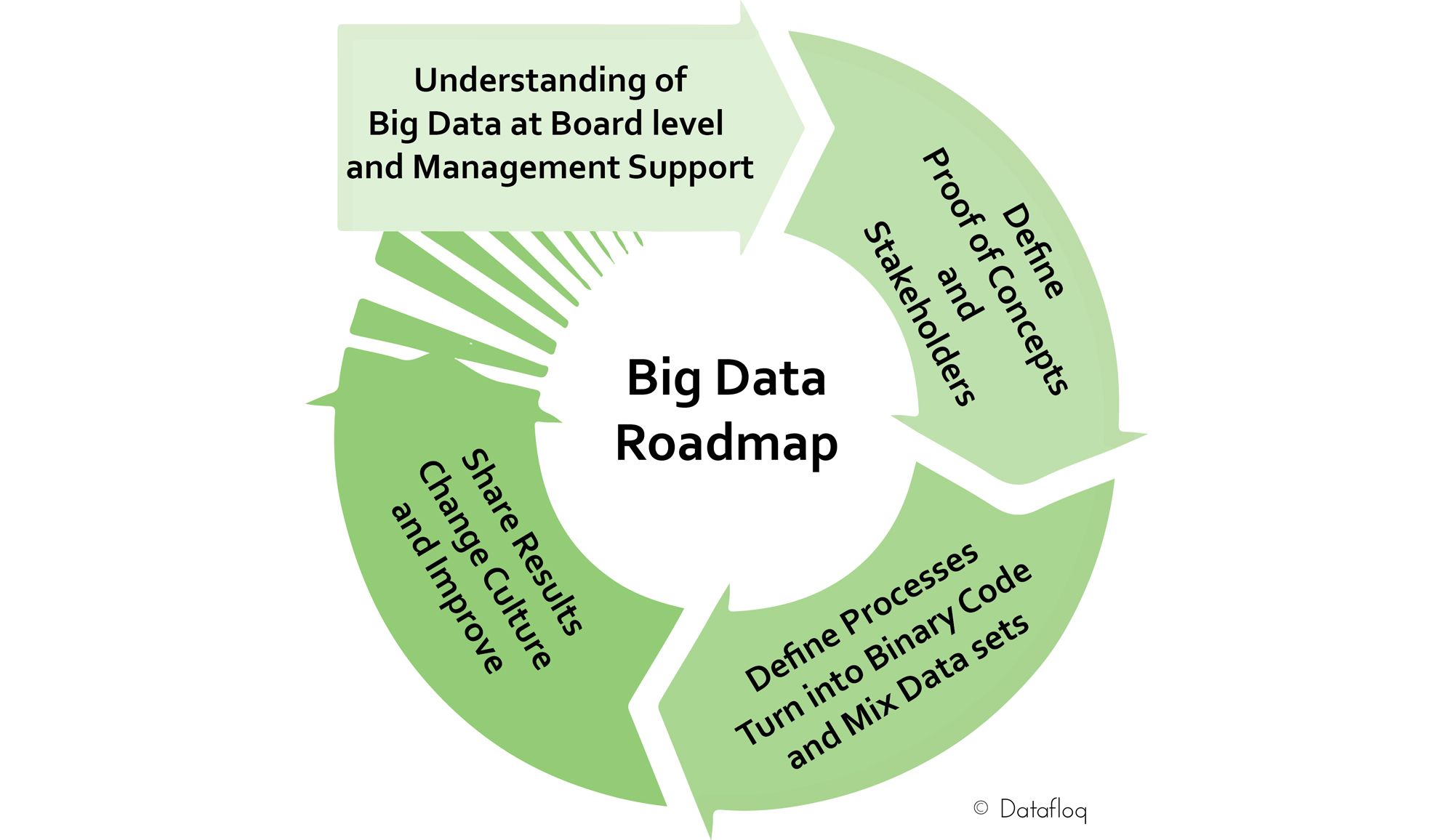The Big Data Roadmap to a Winning Big Data Strategy

Knowing what big data is, is one; knowing what a big datastrategy is two; knowing how to implement that big data strategy is even more difficult. At least, that is how a lot of organisations perceive it. And it must be said, in large process-directed organisations, what most of the large corporates are, it can be difficult. Convincing the board and defining were to start could be a daunting task. While in fact the steps that need to be taken are clear and straightforward. This roadmap can help you in defining and implementing the right big data strategy.

So, there are four basics steps that you should follow to build a winning Big Data Strategy:
Understanding of Big Data at Board level and Management Support
Big Data means something different for any industry, any organization and every person. Therefore, it is important that organisations need to have a shared understanding what big data is to begin with. Otherwise defining a strategy is impossible. If this shared understanding is not present within your organization, everyone will start from their own point of view, resulting in a confused strategy.
Knowing what big data is can help you to get management buy-in at your organisation. Big data is a strategy matter, and not an IT matter. IT is merely supportive and therefore senior management or the board should be involved and support the decision to move forward with big data. Especially because in the beginning the returns on the investments made are still unclear and could potentially be negative in the beginning. Management support ensures that the project is not stopped before any real results can be shown.
Define Proof of Concepts and Stakeholders
When senior management or the board approves the decision to move forward, it is important to get together a multi-disciplinary team from all different departments within the organisation. Data tends to be kept in silos throughout the organisation, if you focus on only one part of the company, valuable data sources could be kept left out.
So, involve members from the marketing department to get the customer point of view. Involve product management to understand how data is gathered in the products or services offered. Involve human resources to understand the impact of data gathering on employees. Involve risk and compliance to ensure that your organisation sticks to the four ethical guidelines discussed earlier. Ensure the finance department to keep the budget under control and of course involve the IT department to build the necessary hardware and software.
Involving all departments within the organisation has a major advantage. When you start to define possible Proof of Concepts, the brainstorm sessions will become a lot better when people from different disciplines are involved. Each member of the multi-disciplinary big data team can offer a different point of view on data and together a large pool of possible use cases can be defined.
It is important during this phase to accept all possible use cases that are brought up during the brainstorm sessions (as in normal brainstorm sessions, ‘no’ and ‘that’s not possible’ do not exist). It is essential to let creativity flow, as this will allow you to find new data sources previously not thought of.
Once you have outlined a few dozen possible use cases it is time to define criteria to rank all use cases. It will help to divide the use cases into different categories first, like use cases that fix bottlenecks or use cases that improve the efficiency of business processes. Use the criteria to rank all use cases in the different categories.
Criteria can be the impact it has on IT, the impact to implement the suggested solution and/or a possible value proposition. It is no use to completely develop a scenario analysis for each use case, as there are too many unknowns at this moment.
Based on the criteria and the categories it is then time to select the Proof of Concepts that will be implemented. Define which stakeholders are important to involve in the project, next to the internal multi-disciplinary team. The multi-disciplinary big data team should be able to implement these Proof of Concepts with minimal efforts. It is better to fail fast and fail often than to develop a complete solution and in the end notice that a wrong turn was taken.
Although big data has the potential to bring a lot of positive results, it is likely that this is not visible from the beginning. Don’t be afraid to fail and start over again in this phase, as it is part of the learning curve how to deal with big data and to better understand how your organisation can best benefit from it. For each organisation after all, the benefits will differ.
The moment the first results come in, it is time to share the results immediately with the entire organisation. Try to get the entire organisation involved in the big data efforts that are done, as this is a requirement for organisations to truly succeed with big data.
Define Processes, Turn Them Into Binary Code and Mix Datasets
Once you have started with a Proof of Concept, it is important to use a wide variety of data sources. More data sources will give you better insights, a process I like to call Mixed Data. When the required data sources are not available, look for possibilities to create them. You can think of adding sensors to your products to gather data or to purchase or download public and open data sets.
The next step is to develop the technology to analyse the data. You can use a multitude of analytics techniques such as data mining, clustering analytics or predictive analytics. The technology can exist of a Software-as-a-Service solution or a tailor-made solution, depending on the requirements.
Share Results, Change Culture and Improve
If the results of the Proof of Concepts are positive, it is time to expand the multi-disciplinary big data team throughout the organisation and to start more and larger projects. As the organisation has learned from the Proof of Concepts, it will be possible now to extrapolate the results of the first projects to the new projects. With the lessons learned it is feasible to better define a possible ROI, IT impact, possible process implications and other important criteria.
From there on, the entire process starts all over. For each new project that is done, it is of course important to fail less and implement faster, getting faster results and a more positive result. Whichever use case is chosen, in the end it will affect the net results of the organisation positively, as long as the big data projects are implemented wisely and correctly. Of course, this is not always easy so in case your organisation needs help, it is possible to contact us.
In the end, this roadmap can help your organisation develop and implement a big data strategy that is good for the company, good for your customers and good for society. Big data is too important and has too many implications and advantages to be ignored. So do not waste time and get started developing your big data strategy.





